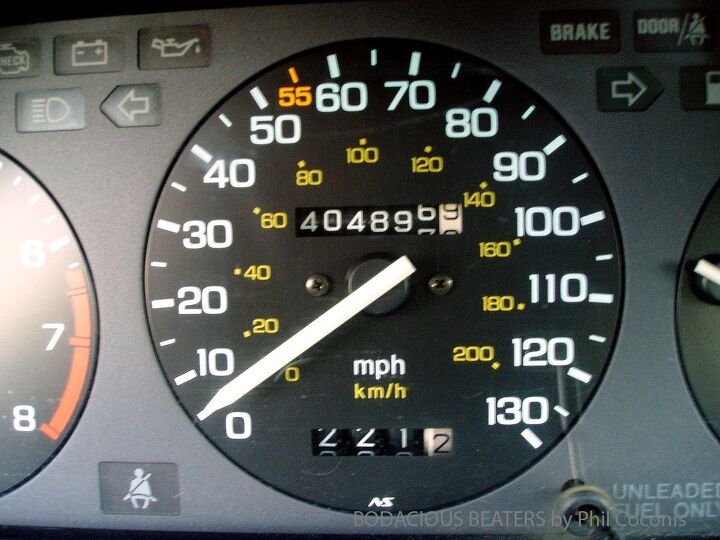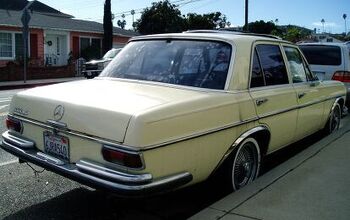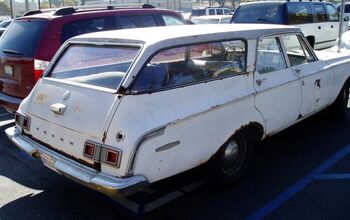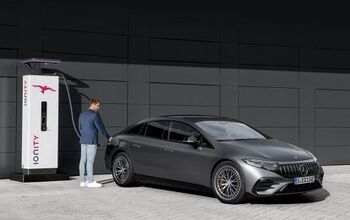BODACIOUS BEATERS and Road-going Derelicts: UNANIMOUS ACCORD
Periodically, I’ll be featuring some outstanding vehicular examples from the bodacious photo archives, as I have done already in the past (see “LO-LUX”). I wanted to get this one out before the end of the year, so here you go!
Hearing about the outrageously high-mileage original vehicles is one thing—and continues to be the stuff of urban legend—seeing physical proof of one is another matter, entirely. Of all of the well-worn autos I’ve had pass through my shop, I’ve never seen one displaying this kind of mileage, and in this kind of bodaciously original condition.
he first time I was granted the privilege of laying a wrench on this 1989 Honda Accord Lxi Coupe, I had to do a double take of the odometer reading, as I was writing the repair order up. It just didn’t seem to jive with the general condition of the vehicle. While showing signs of definite use, upon closer inspection, it was the kind of use I’d normally have associated with an example displaying one-third the mileage.
Yes, the paint was somewhat “swirly” and dull—if not even in appearance and devoid of impact damage (even on the bumpers, which possessed a notoriously wimpy painted “shell”)—and the interior controls (steering wheel, gearshift and HVAC interface) were worn a little smooth in places. But overall, the unit neither looked nor drove like a motor vehicle that had made the equivalent of a round trip to the moon and change! The customer told me pretty much EVERYTHING was original and undisturbed—including engine and transmission—save for the usual and customary maintenance. I was a bit skeptical about that, but I wasn’t going to dismiss it out of hand, either. People in the know were (and are) aware of the high level of materials and build quality, and fit and finish of Honda products from this period.
It’s doubtful we’ll ever see such examples of this combination again.
To add emphasis to this statement, I’ll relate why this car was in my shop in the first place. It wouldn’t start at the beginning of the day. The engine would spin all right, but it would no fire. Typically on these models, the problem would be something like a failed fuel pump or relay, worn distributor, or ignition switch. It turned out to be none of these.
We had been having some damp weather, but it was sunny and dry the next morning when I went to test it. It fired right up.
I would then typically have a look at the secondary ignition system (especially the spark plug wires—a design concept long since supplanted by coil-on-plug spark delivery systems). I figured that somewhere along the way, someone performing maintenance would have found it necessary to change those spark plug wires.
On most Japanese vehicles, the production date would be printed on the wire itself. I would generally recommend replacement at the ten-year mark, regardless of mileage. I found their performance to be somewhat suspect beyond that point.
These particular leads read “1988”, however. Somehow, this set of wires had slipped between the proverbial cracks! They were the original units—well over twenty years old! The customer hadn’t been exaggerating—the car really WAS that original!
With a new set of wires installed, the ol’ Accord ran as good as new.
No joke. And the pop-up headlights (a design exercise whose passing I’ve lamented ever since) still worked, too!
Phil has written features and columns for a number of automotive periodicals and web-based information companies. He has run a successful Auto Repair Business in the past for many years (See “Memoirs of an Independent Repair Shop Owner” on this ttac site). He can be contacted through this very site, or http://www.linkedin.com/
More by Phil Coconis
Latest Car Reviews
Read moreLatest Product Reviews
Read moreRecent Comments
- Honda1 Unions were needed back in the early days, not needed know. There are plenty of rules and regulations and government agencies that keep companies in line. It's just a money grad and nothing more. Fain is a punk!
- 1995 SC If the necessary number of employees vote to unionize then yes, they should be unionized. That's how it works.
- Sobhuza Trooper That Dave Thomas fella sounds like the kind of twit who is oh-so-quick to tell us how easy and fun the bus is for any and all of your personal transportation needs. The time to get to and from the bus stop is never a concern. The time waiting for the bus is never a concern. The time waiting for a connection (if there is one) is never a concern. The weather is never a concern. Whatever you might be carrying or intend to purchase is never a concern. Nope, Boo Cars! Yeah Buses! Buses rule!Needless to say, these twits don't actual take the damn bus.
- MaintenanceCosts Nobody here seems to acknowledge that there are multiple use cases for cars.Some people spend all their time driving all over the country and need every mile and minute of time savings. ICE cars are better for them right now.Some people only drive locally and fly when they travel. For them, there's probably a range number that works, and they don't really need more. For the uses for which we use our EV, that would be around 150 miles. The other thing about a low range requirement is it can make 120V charging viable. If you don't drive more than an average of about 40 miles/day, you can probably get enough electrons through a wall outlet. We spent over two years charging our Bolt only through 120V, while our house was getting rebuilt, and never had an issue.Those are extremes. There are all sorts of use cases in between, which probably represent the majority of drivers. For some users, what's needed is more range. But I think for most users, what's needed is better charging. Retrofit apartment garages like Tim's with 240V outlets at every spot. Install more L3 chargers in supermarket parking lots and alongside gas stations. Make chargers that work like Tesla Superchargers as ubiquitous as gas stations, and EV charging will not be an issue for most users.
- MaintenanceCosts I don't have an opinion on whether any one plant unionizing is the right answer, but the employees sure need to have the right to organize. Unions or the credible threat of unionization are the only thing, history has proven, that can keep employers honest. Without it, we've seen over and over, the employers have complete power over the workers and feel free to exploit the workers however they see fit. (And don't tell me "oh, the workers can just leave" - in an oligopolistic industry, working conditions quickly converge, and there's not another employer right around the corner.)


































Comments
Join the conversation
"Joe LoCicero purchased “True Blue,” his 1990 Accord LX, from an elderly couple in 1996. At the time, the car had roughly 74,000 miles on it; that’s an average of around 12,000 miles per year. Today, it has 1,002,515.9 miles on the odo—meaning Joe’s averaged in the neighborhood of 58,000 miles per year since. A former Honda mechanic and an inveterate tinkerer, Joe set out to prove that proper maintenance could extend the life of his Accord. After soaring past the 700,000-mile mark, though, Joe figured he just had to go for 1,000,000 miles. He accomplished this extraordinary feat in early 2011. After 15 years, Joe’s Accord has racked up 185 oil changes, 72 tires, 31 transmission fluid changes, 13 sets of front brake pads, and a new muffler. In all that time, Joe never opened the engine, never got in an accident, and was only towed once—when the original fuel pump finally died at 741,000 miles." http://accordroadtrip.motortrend.com/
That was my first car! 1989 Honda Accord LXi Coupe, 5-speed, black with tan interior. I loved that car. Bought it at 120,000 miles and drove it to 168,000 miles. Only issues were a dead driver's side power window and dead tape deck. Other than those issues, the car never failed me. Day after I bought it I drove from Boston to Rochester, NY in a blizzard to see my girlfriend who was still in school -- 12 hours in a whiteout, only car on the highway, while learning to drive stick. After I got my next car (a '97 Prelude), I garaged it for six months while I was figuring out what to do with it. Got in an accident in the Prelude and had to go back to the Accord while it was repaired. Started up on the first try. Finally lost it when the battery died and I had to move it into the street for my landlord to do some work on the driveway. The city towed it and I couldn't afford the bill at the time. I'll hate that $%#!@& tow driver forever. I have driven faster cars, more luxurious cars, better handling cars, more comfortable cars... But in my opinion, there has never been a better overall car. If I had the opportunity today (and a garage to work on it), I would buy one in an instant. I'd fix it up, keep it running and give it to my daughter as her first car... 14 years from now. :) And yes, the pop-up headlights always worked. Plus there was the wink! There was a button on the dash that opened the headlights and kept them up (so they wouldn't get frozen shut in winter). If you tapped that button really lightly, just one of the lights would open and close quickly. Man, I loved that car.